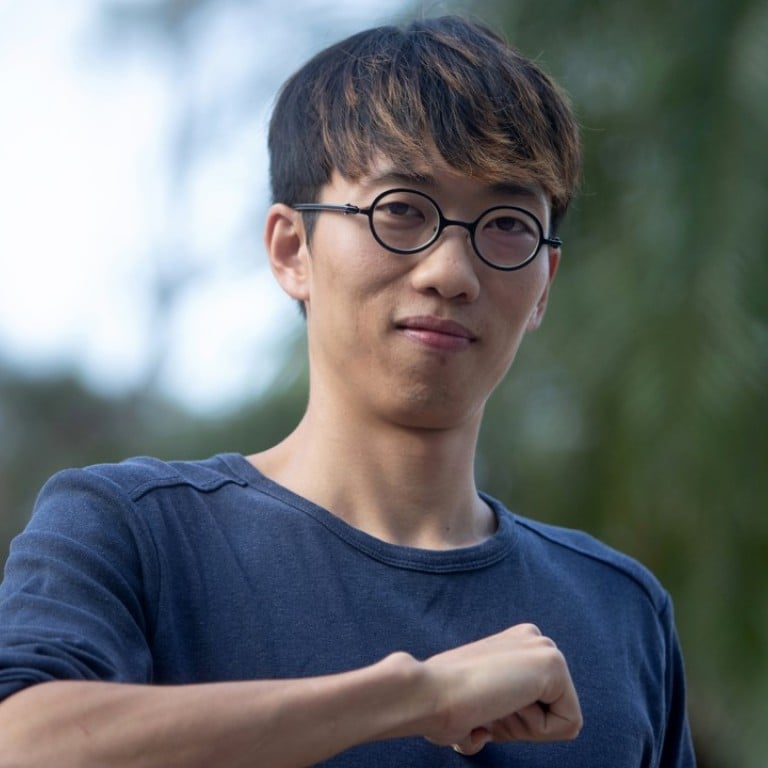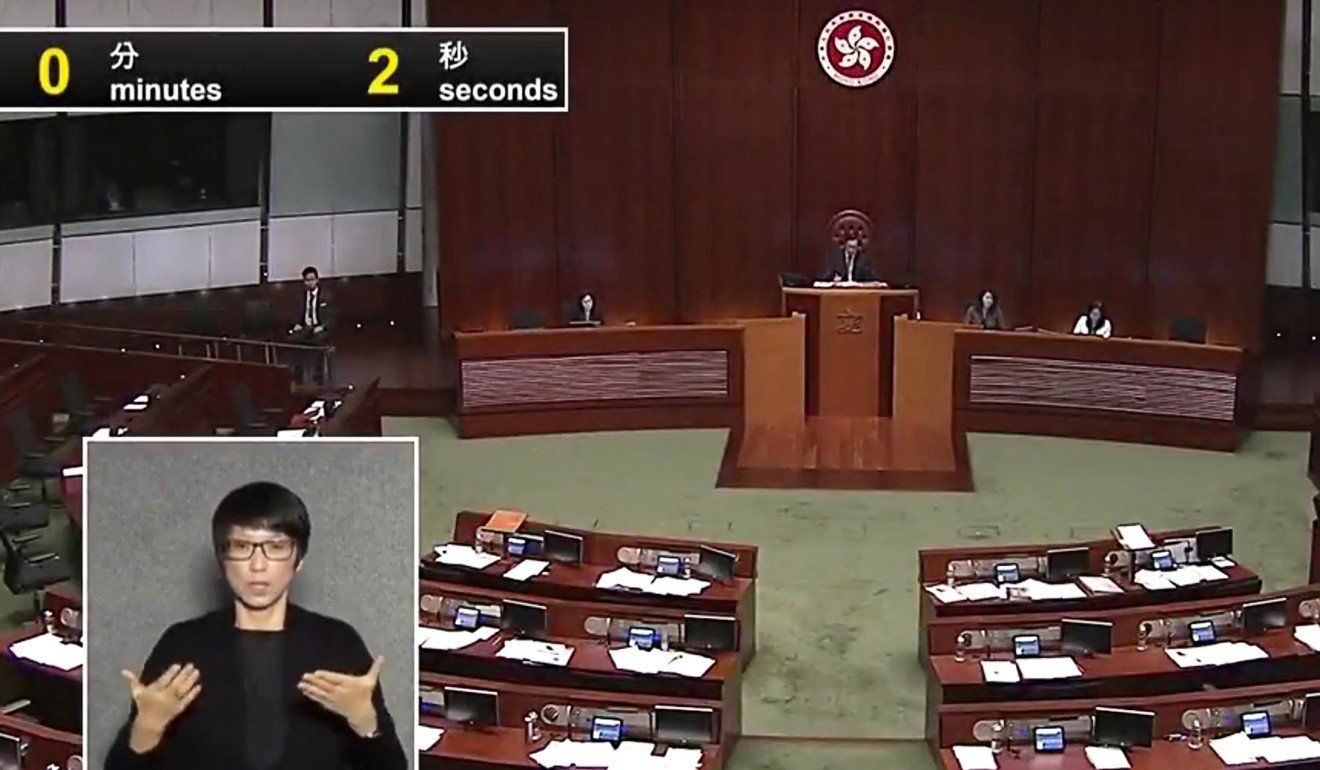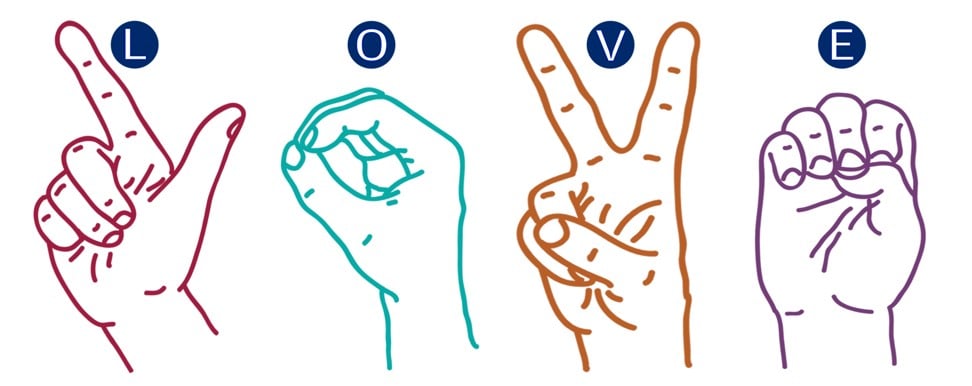
Don’t silence sign language: call for dying medium to be revived and used as teaching tool for deaf in Hong Kong
- Some 155,000 people in city have hearing disabilities, but only about 5 per cent of them know sign language, which has been sidelined in education
- Experts argue medium can be used in various therapies and improve learning abilities of deaf or hearing-impaired students
Aaron Wong Yiu-leung, 33, who was born deaf, has lived in a silent world all his life.
At 18, he dropped out of vocational school. Although he is proficient in sign language, having learned it from his parents who are also deaf, it was rarely used in classrooms, and he just could not keep up with his peers as he struggled with lip-reading his teachers.
For the next seven years, Wong worked odd jobs in restaurants and garages.
“I thought: ‘This is it. This is the best I can do for the rest of my life’,” he says in an interview through sign language with the help of interpreters Kim Wu Lake-yan and Ham Chu Man-him.
Some 155,000 people in Hong Kong have hearing disabilities, but only about 5 per cent of them know sign language, according to linguistics expert Professor Gladys Tang Wai-lan.
This is partly because the use of sign language is not encouraged in Hong Kong’s education system.
Wong attended kindergarten, primary and secondary school at the Hong Kong School for the Deaf.
But sign language was not part of the curriculum at the school, and teachers taught using oral and written communication. The school was later renamed Chun Tok School, and now provides only mainstream primary school education.
How the embrace of non-verbal communication is a welcome sign of the times
Today, the only special school catering to those with hearing disabilities in the city, the Lutheran School for the Deaf, provides 64 students with primary and secondary school education.
Other hearing-impaired students attend mainstream schools under the integrated education plan. Authorities believe inclusive education provides equal education opportunities to students, including those with special needs.
But experts have highlighted that the low usage of sign language in the education system contributes to delays in language development among deaf or hearing-impaired students, limits personal development, and confines them to jobs that require little or no interaction with colleagues – thus reducing social participation.

And with only about 50 sign language interpreters in Hong Kong, there are hardly enough services to help the hearing-impaired or deaf overcome daily tasks that others often take for granted.
A 2014 study by Chinese University’s Centre for Sign Linguistics and Deaf Studies (CSLDS) found that among 98 deaf students who attended mainstream schools, some 65 per cent of the severely deaf experienced severe delayed language development, while 60 per cent experienced some degree of language development delay.
Being deaf won’t stop Winnie Cheung from pursuing dream of playing rugby for city
“Lip-reading isn’t foolproof at all. We missed out on a lot of information trying to lip-read teachers,” Wong says. “We tried communicating by writing, too, but very often I couldn’t understand what was written because it would contain words I didn’t know, or I just couldn’t figure out the sentence structure.”
Experts believe sign language can help such students learn by providing them with a barrier-free language that could help them understand the curriculum.
A dying language
School was fun and games for Wong until secondary three, when the time came to prepare for the citywide secondary five leaving exam, or the Hong Kong Certificate of Education Examination (HKCEE).
According to Wong, his school simplified the syllabus to make it easier for students to keep up, but that meant they lagged behind those from mainstream schools.
“One teacher said to us: ‘You’re going to fail the HKCEE’s’,” Wong recalls. “My immediate reaction was: ‘So does this mean we can drop everything and go play?’”
Wong and most of his peers never dared imagine an academic future beyond the HKCEE. Many of Wong’s peers joined the workforce upon finishing the exam.
Deaf technicians find inspiration with events company after lifetime of discrimination
After graduating from Form Five in 2003, Wong went on to study computer systems at the Hong Kong Institute of Vocational Education.
“All the teachers and my peers communicated orally,” he recalled, adding that he could not understand accurately what was going on in class. “My classmates didn’t want to help me either,” he says through sign language. “I was isolated.”
Wong dropped out of the course after only four months. Over the next seven years after leaving vocational school, he worked odd jobs.
According to Chris Yiu Kun-man, a senior programme officer from CSLDS, Wong’s story is not uncommon.
“If oralist-only education worked, delays in language development wouldn’t be as prevalent,” Yiu says. “You need a good language foundation to learn. Children who can’t communicate well by hearing or speaking are naturally going to gravitate towards signing.”
Unlike prescription eyewear, which can give wearer perfect vision, hearing aids cannot restore hearing. The devices can only amplify sounds, which means those who are hearing-impaired will have to combine what they hear with lip-reading to piece together what people are saying.
It’s the education system that has failed them by not giving them a language with which they can receive education and communicate
“Without an effective way to communicate, [deaf and hearing-impaired] students learn in fragments,” Yiu says. “And it’s the education system that has failed them by not giving them a language with which they can receive education and communicate.”
Sign language in schools was banned worldwide in 1880 at a multinational conference of deaf educators after it was decided that oral education was better than sign education. The tide began to turn in 1960, when an American linguist found compelling evidence that sign language shares the essential characteristics of spoken languages.
In 2010, a formal vote was made at the same conference, and it gave the deaf community the freedom to be educated in their methods of choice.
“After decades of research, we concluded that language is in the head,” says Professor Gladys Tang, who is also CSLDS’s director. “We can express language using different methods – by speaking, listening and signing.”
But Hong Kong’s education system is not based on the same concept.
Guidelines by the Education Bureau’s Audiological Services Unit, last updated in 2015, emphasise the importance of facilitating lip-reading and hearing for deaf or hearing-impaired students at mainstream public schools. Authorities believe these methods can effectively help students adapt to everyday life and the learning environment, and develop their potential.
But there is still no mention in bureau guidelines of using sign language as an aid. Free rehabilitation services provided by the government for children with hearing disabilities in schools also do not include the option of sign language.
How an ex-Hong Kong swimmer learned to deal with her infant son’s deafness
Deaf or hearing-impaired children who wish to learn sign language have to turn to private organisations and tutors, which come at a price. For example, a year’s worth of sign-reading classes for children aged three to six would cost HK$6,000 for 30 classes at SLCO Community Resources, a non-profit charitable organisation.
“What could be more beneficial to these children and their social integration than nurturing them to be proficient in both sign and spoken language?” Tang. “Why not give them the option to switch between sign language and speech, depending on who they interact with?”
What could be more beneficial to these children and their social integration than nurturing them to be proficient in both sign and spoken language?
Classrooms abroad appear to be more open towards the idea of sign language, and providing support services for deaf students. Mayflower Primary School in Singapore, for example, uses sign language as the teaching medium for pupils with hearing loss.
For core subjects such as English and maths, a specialised staff member proficient in sign language teaches alongside a mainstream teacher, while a sign interpreter is present during non-core subjects, such as art and music.
“It’s a real pity that the bureau shuns sign language as a way to support deaf children in mainstream education,” Tang laments.
“When deaf and hearing children are brought up in the same environment, using both sign and spoken language to learn, the curriculum becomes more accessible to both.
“It’s like being able to use both Chinese and English to study the contents of a certain subject. You’ll learn more about it from different angles.”
On Hong Kong’s integrated education system, education sector lawmaker Ip Kin-yuen expressed concern that teachers at mainstream schools do not have adequate training and sufficient time and energy to take care of the needs of students with hearing disabilities.
Action speaks louder than words for social enterprise that hires deaf technicians
“While there is training, it’s certainly not comprehensive enough, and I doubt many teachers have received it,” Ip says. “It’s also a well-known fact that teachers in Hong Kong are always pressed for time and have to juggle administrative tasks, extra curricular activities, and so on. It is inevitable that these distractions would take up some of their time and energy.”
Meanwhile, note-taking and captioning services are widely available in North American and European universities. Yiu says Hong Kong should consider adopting these services more widely.
Yiu adds that sign language could even support speech training. Speech therapists may use sign language to deliver speech training instructions to deaf children who can’t understand verbal directives. It also allows therapists to understand children who cannot enunciate properly.
Tang says research shows sign language can be beneficial, even to hearing individuals.
“In hearing babies, sign language can boost right brain development as oral communication uses more of the left brain,” Tang says. “In hearing adults, sign language can help slow cognitive decline as we age.”
According to Tang, clinical psychologists working with autistic children and children with developmental delays at Heep Hong Society have also reported faster and better development among children who have been learning sign language with CSLDS.
A different future
“As a kid, I would make it a point to speak with people to show that I could, and that I was more capable than other deaf people,” Wong says in sign language. “I believed oral communication was superior to sign language.”
In 2008, Wong started his own car-washing business. While it gave him job satisfaction, washing cars was gruelling work. This was one reason why, two years later, Wong’s family urged him to go back to school when he came across the Asia-Pacific Sign Linguistics Research and Training Programme at CSLDS while searching for sign interpretation courses for his hearing sister.
There, he began to embrace his deafness, and now prefers to be called “Deaf” with a capital “D” – a community term coined to describe those who share a common culture and sign language – to reflect his pride in what he considers his cultural identity.
The five-year diploma programme was taught in sign language by both deaf and hearing instructors. Wong has just graduated with a bachelor of arts in linguistics from the university, and is now a part-time research assistant at CSLDS.
The diploma programme introduced Wong to a world he never thought existed.
“I never knew deaf people could be teachers. I never thought I would finally be able to understand everything that was taught in class. I never imagined I would set foot on a university campus – like the kids in movies,” Wong recalls.
I never knew deaf people could be teachers. I never thought I would finally be able to understand everything that was taught in class
“Because everyone around me was using sign language, I was able to keep up with my peers. I then realised how much I actually enjoyed learning, and gradually came to terms with my ‘Deaf’ identity.”
Despite his new take on life, Wong still finds everyday tasks difficult. Many companies and government departments can arrange for sign interpretation services, but typically require an advance notice three days to a week before an appointment. However, as Wong points out, life seldom goes according to plan.
“How would I know three days in advance that I would need to go to the emergency room?” he says. “And what happens when I have to report a lost credit card over the phone – I wouldn’t be able to communicate with the person on the other end of the line without a sign interpreter.”
To Wong, taking the minibus can also be challenging. “If the minibus has no bell and nobody calls for my stop, I often yell for the bus to stop at the very last minute.
“As you can imagine, most drivers find it really annoying.”
The police force has an emergency text message service for speech- and hearing-impaired persons. But unlike the 999 emergency hotline, users have to register for the service in person at designated centres, and pay a mobile phone service charge every time they use the service.
“Why should deaf people have to pay for a service that everyone else can enjoy for free?” questions Yiu from the CSLDS.
Tang says she hopes an improved understanding of sign language could help raise awareness towards the needs of people with hearing disabilities. In the coming academic year, her department will be launching a two-year top-up degree programme – bachelor of arts in bimodal bilingual studies – which teaches sign linguistics at an undergraduate level. The programme will offer 20 places.
“Our quota definitely can’t fill the gap,” Tang admits. “But if we can nurture students who are fluent in sign language, and can apply the skill to their work as social workers, special education teachers, sign language interpreters, and so on, then perhaps we can show how sign language can address some of the problems deaf people face.”


